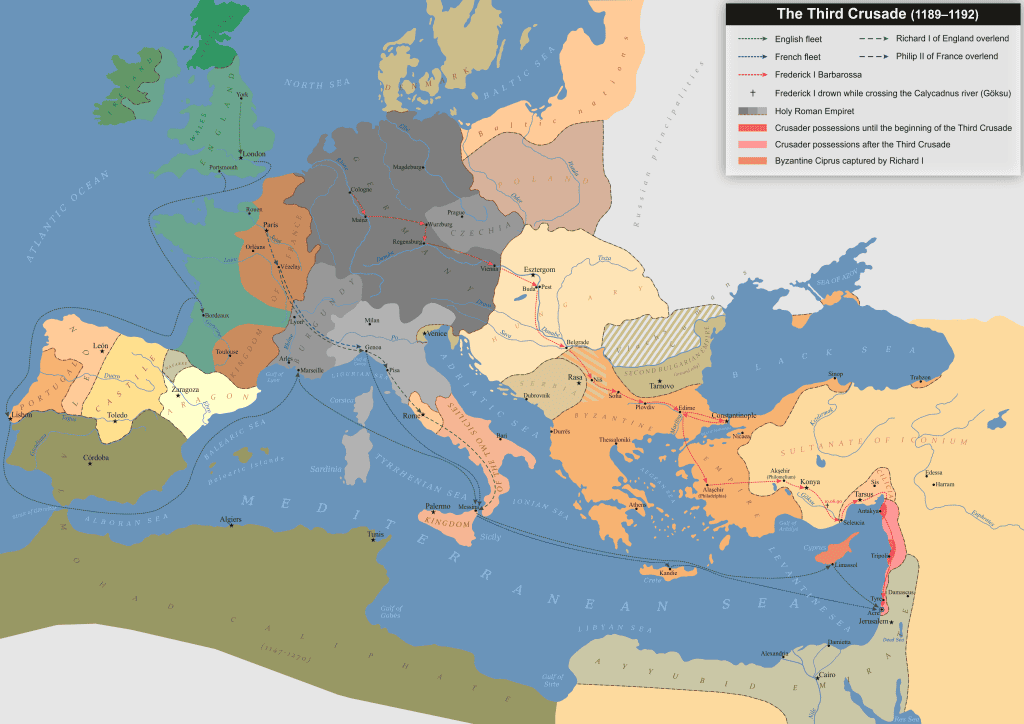The Third Crusade, which spanned from 1189 to 1192, was one of the most significant and dramatic campaigns of the medieval Crusades. This military expedition was launched by European Christian leaders in response to the capture of Jerusalem by Muslim forces under the command of Saladin in 1187. Here’s an overview of the Third Crusade!
The Crusades

Third Crusade – Background:
Fall of Jerusalem (1187): The catalyst for the Third Crusade was the Battle of Hattin in 1187, in which the forces of Saladin decisively defeated the Crusaders. Following this battle, Saladin’s forces captured Jerusalem, a city of immense religious and symbolic significance to Christians.
Papal Call to Arms: Pope Gregory VIII issued the papal bull “Audita Tremendi” in 1187, calling for a new Crusade to retake Jerusalem from Saladin and restore it to Christian control.
Key Figures:
Saladin (Salah ad-Din): Saladin, a skilled Muslim military leader and the founder of the Ayyubid dynasty, played a central role in the events leading up to and during the Third Crusade. He had captured Jerusalem in 1187 and emerged as a formidable adversary.
Richard the Lionheart (Richard I of England): Richard, known for his bravery and military prowess, became one of the most prominent leaders of the Third Crusade. He was the King of England and, later, Duke of Normandy and Aquitaine.
Philip II (Philip Augustus) of France: Philip II joined Richard in the Third Crusade, forming a powerful Christian alliance against Saladin.
Emperor Frederick I (Frederick Barbarossa) of the Holy Roman Empire: Frederick led the German contingent of the Crusade and was a respected leader in Europe. His death during the campaign significantly impacted the Crusade’s dynamics.
Major Events:
Siege of Acre (1189-1191): Acre, a coastal city in the Holy Land, became a focal point of the Third Crusade. It was subjected to a prolonged siege by the Crusaders, ultimately ending in their favor, with the city’s capture in 1191.
Death of Emperor Frederick: In 1190, Emperor Frederick I drowned in a river while traveling to the Holy Land, leading to a loss of leadership for the German Crusaders.
Battle of Arsuf (1191): Richard the Lionheart’s forces scored a significant victory over Saladin’s army at the Battle of Arsuf, securing a vital coastal route to Jerusalem.
Jaffa and Treaty with Saladin: After several battles and negotiations, Richard reached a settlement with Saladin that allowed Christian pilgrims access to Jerusalem, though the city remained under Muslim control.
Sixth Crusade
Third Crusade – Outcome:
The Third Crusade did not achieve its primary objective of recapturing Jerusalem. However, it did result in significant territorial gains for the Crusaders, including the coastal cities of Acre, Jaffa, and other key strongholds.
The truce between Richard the Lionheart and Saladin allowed for a Christian presence in the Holy Land and ensured peace in the region.
Richard’s departure from the Holy Land in 1192 marked the effective end of the Third Crusade. He left behind a complex legacy, as the unfulfilled goal of reclaiming Jerusalem tempered his accomplishments.
The Third Crusade had a lasting impact on the politics and dynamics of the medieval Holy Land. It highlighted the resilience of both Crusader and Muslim forces and the complexities of diplomacy and warfare during this tumultuous historical period. More about the Third Crusade in this link!

